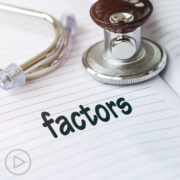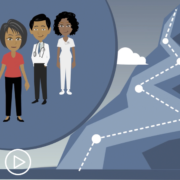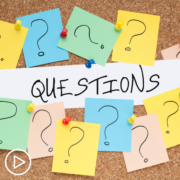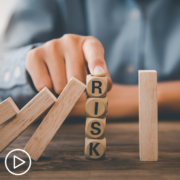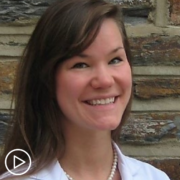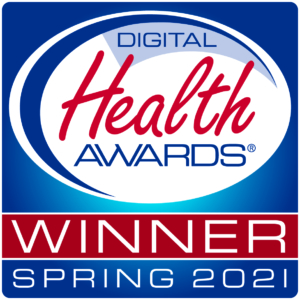A dynamic panel discusses the important aspects of care for AML patients, with a focus on the emotional side effects, research on new treatments underway and finding suitable clinical trials.
Coping With the Emotional Side Effects of AML from Patient Empowerment Network on Vimeo.
Downloadable Program Guide
Transcript:
Beth Probert:
Hello, I’m Beth Probert, and I am a patient advocated and ambassador with Patient Power.
I am also an MPN patient. Thanks for joining us for this Patient Empowerment Program in partnership with The Leukemia and Lymphoma Society. Today, our program is: Coping with the Emotional Side-Effects of AML. And we are joining our AML community.
We’re gonna focus on where we’re headed with treatment of Acute Myeloid Leukemia; what patients can look forward to in the coming year.
We will also answer questions that you can submit to AML at patientpower.info. And please note that we cannot provide specific medical advice over the internet. And it wouldn’t be fair to you. We always recommend that you seek care from your own doctor or AML specialist, and that’s how you will get the best treatment for you.
I’d like to start now and introduce our panel. And we’ll start off with Dr. Thomas LeBlanc. A medical oncologist, palliative care physician, and patient experience researcher from Duke Cancer Institute. Welcome, Dr. LeBlanc.
Dr. LeBlanc:
Hi, thanks for having me.
Beth Probert:
And I would like to introduce Michelle Rajotte. She is the Associate Director of the Leukemia Lymphoma Society’s Information Resources Center. Michelle has been with LLS for 13 years. Hi, Michelle.
Michelle Rajotte:
Hi, good to be here.
Beth Probert:
Thank you. And last but not least, I’d like to introduce our patient advocate today, James Bond. And James has survived Multiple Myeloma for 27 years, and AML for the past 7 years. James and his wife, Kathleen, have shared their story in 29 states. And patients can contact him directly at his email, which is Jim.Bond48@gmail.com.
So, thank you for joining us today, Jim.
James Bond:
Happy to be here.
Beth Probert:
Great. Well, Dr. LeBlanc, I would like to start with you. Tell us a little bit about your background in AML and palliative care, please.
Dr. LeBlanc:
Sure. So, by training I’m an oncologist. But when I went through my cancer care training, I realized that oftentimes we fail to really attend to some of the issues that are most important to patients and families. And those might be things related to symptom burden, quality of life, emotional well-being, communication, understanding of prognosis.
And so, I ended up pursing additional training in palliative medicine where those types of issues really are the focus. And in doing so, got a sense that really adding specialist palliative care to cancer care and blood cancer care particularly, really could improve many aspects of the experience for patients and families.
And ultimately that is what my clinical practice and research have come to focus on. But in my clinical practice, I largely see patients with myeloid malignancies, including Acute Myeloid Leukemia and some related conditions.
Beth Probert:
That is so interesting and very unique because very often we see our doctors and we don’t get the whole palliative side of it. So, I can honestly and personally say that that is just a wonderful added bonus. Thank you.
And Michelle, can you tell us a little bit about your role at LLS, and really what the goal of the information resource center is?
Michelle Rajotte:
Sure. So, I’m part of the Information Resource Center at Leukemia Lymphoma Society. Which, The Leukemia and Lymphoma Society’s main goal is to help find a cure for Leukemia, Lymphoma, Hodgkin’s disease, Myeloma, and improve the quality of life of all patients and their families.
And IRC is apart of that. So, basically, what we do is – it’s staffed by information specialists who are master level, either social workers, nurses, or other healthcare professionals who’ve been trained in blood cancer. And we can do anything from answer questions, provide disease information, help with clinical trial searches, find different support resources, refer to other organizations if we need to for other resources. But really, it’s anything that someone needs in the moment.
So, we’ll talk with them over the phone, through email, or through chat online, and we figure out what it is that they need based on talking to them, or whatever they provide to us. And then, provide them with the resources and support they need.
Beth Probert:
Wow. And that is just invaluable. And we definitely need to bring focus to the cancer patients and what your department could ultimately provide to them. Thank you.
So, Jim. You are a long-time survivor. How has your cancer diagnosis impacted you emotionally?
James Bond:
Well, it’s been like riding a roller coaster. My care-giver wife, Kathleen, Kathleen is sorry she can’t be joining us today. But the lowest point, of course, was getting diagnosed with a deadly incurable blood cancer. My first one, Multiple Myeloma. And then the second one, AML, many years later.
And so, what we tried our best to do is, to try to even out that roller coaster ride emotionally. And, I’ll give you an example, after 10 years of dealing with Myeloma, I was told, Jim, there’s nothing left that can help you, you need to go to a hospice. And that was obviously crushing.
And what we tried to do is pull each other up and say, “Look, we’ve been through tough spots before.” And we figured out that just rely on the doctors, rely on our own research ability, and they’ll be something coming up. And we were able to figure out, hey, there’s a clinical trial that was mentioned to us, and within a month of being told to go to a hospice, we were out of town in a clinical trial, and within two weeks, I was told, “You’re in remission.”
So, that was a tremendous high. And again, what we try to do when we get really good news is pull each other down and try not to be so excited, but we try to even things out. And that’s very difficult to execute, but for 27 years now, we’ve had a good deal of experience. There are a few other tings we do emotionally, we say, “Look, let’s do all we can, and then let’s not look back and second guess ourselves.”
And even to make it more normal, we cut off all cancer discussions with ourselves, ideas, or with a family member at 8:00 p.m. our time. We say, “You know what? Let’s just do what we’re gonna do at night, and let’s defer that to the morning.” That tends to let our emotions calm down and let us live more normal lives. At least in our minds.
It has not been easy. It’s been very difficult and emotionally at times, we’ve actually played a role of trying to lift up the medical team who, the AML diagnosis in particular, they explained to me, “Jim, you’re 64 years old,” When I got AML, that was seven years ago. They said, “Your chances of survival are not good. The only way you can live is through a fourth bone marrow transplant. And this one has to be not from your matching sister, but from an unrelated donor, if we can find one.”
So, they really encouraged me to consider just hanging up, but our approach, and this helps us emotionally is, no, we’re gonna treat this thing called cancer like a problem. We’re gonna put it in front of us, and we’re gonna deal with it as analytically, or unemotionally as we possibly can. And lo and behold, the doctors, as they’d come around in my, I don’t know, 10-week stay in the hospital, whatever it was, they would keep trying to say, “Jim, don’t get your hopes up. This might not work out.”
And it did work out, and we found ourselves much better off by, I do my favorite thing, and that is, I make myself exercise each and every day. And sometimes that exercise is not much, it’s walking with my IV pole around the floor section when doing a transplant.
Or it’s walking on my treadmill on snowy icy Ohio days like today. But that helps me emotionally because it gives me something that’s not cancer, it’s quiet time to think, and it really led to something that’s been just magical in terms of helping both of us emotionally.
When I had to leave town to do the clinical trial, my wife, Kathleen, got to thinking as a long-term volunteer of the American Cancer Society, she realized that there are not enough people in the country aware of these things that the ACS has called, “Hope Lodges.” So, she founded, launched, and leads, to this day – this was 13 years ago, she launched the first one. And I was not a cyclist, but I saw a link between the exercise that I think is so vital for me emotionally and physically, and this bike ride. So, I decided to buy a bike and trained. And I’ll be darned, I’ve ridden it every year four days, 328 miles from Cleveland to Cincinnati.
Beth Probert:
Wow, well that is really inspiring.
James Bond:
Thank you. And that helps me tremendously emotionally because that training and riding takes up a good three and a half, four months of my year, and I look forward to that, and the fundraising is tremendously exhilarating because I get to hear from people that I don’t hear from that often.
Beth Probert:
Yes.
James Bond:
So, the key there is emotionally, I think, is just having a long-term plan, and not letting –
Beth Probert:
And Jim, I’m just gonna jump in really quickly, this is amazing information. So, hold that thought, we are going to jump on some of the thoughts you said, and I do want to say real quickly, I love the, “We” in that. We.
James Bond:
Oh, absolutely.
Beth Probert:
And we’ll click back onto that. So, I’m gonna hop over now to Dr. LeBlanc. And could you go through, with your vast experience, what are the key emotional side effects that you see your ALM patients facing day to day?
Dr. LeBlanc:
Yeah, this is such an important question, and it’s one that we don’t ask often enough, and we don’t talk about these issues very often, unfortunately. So, I’m really excited that we’re having this webinar, first of all. And I’ll tell you, it’s important to recognize as well, every patient, every person is different. So, there is not one quintessential AML experience. That’s really important to recognize.
But at the same time, when we have studied this issue and interviewed patients, and care givers, and family members, there certainly have been some common themes that have come through about people’s experiences. And one of the one that is, I think, particularly important to recognize is the sense of shock at this diagnosis. Now, acute leukemias, we call them acute because they tend to come on very quickly and suddenly.
And many of the patients we see will say things like, “I was fine three weeks ago. And now I can’t even walk up a flight of stairs.” And, “I’m so tired, I’m taking naps, this is not like me. I usually run marathons, and now I can only run a couple miles, something is going on.” And this really degenerates, for many, people over the course of day or a few weeks.
And sometimes it means they end up urgently in the hospital and are told, “You can’t leave. Something’s going on, we don’t really know what it is, but we’re concerned. You might have leukemia.” And if they’re not at a large medical center, they may get shipped off hours away from home to a place that’s not familiar where they don’t know anyone.
So, that shock and suddenness of the diagnosis makes everything else much more difficult, and it sometimes creates, even, social isolation related to where AML is treated. Where it tends to be treated more so at academic centers than it is in the community, although, certainly, some of these treatments are provided in the community.
But patients getting high-dose therapies do tend to come to large research centers. So, we’ve certainly seen that issue impact many patient’s experiences. The other one that comes up quite often, that really compounds the decision making and the emotional difficulties, is the issue of uncertainty. So, unlike many cancers, we really don’t know what to expect when a person is diagnosed with AML. And everyone asks, “Well, what stage is this?” and we don’t really have stages for this disease.
We, certainly, have ways that we can try to get a sense for what we might expect for the patient who’s sitting before us. And we do all kinds of fancy testing, and we talk at length about those issues, but at the same time, we really can’t say what’s going to happen to you, my patient sitting across from me who I’m trying to help guide through the process.
And there are actually a lot more risks associated with Leukemia treatments as you heard Jim talk about. A stem-cell transplant is a difficult and risky process, and sometimes that’s part of curing AML, or hoping to cure AML. But even high-dose chemotherapies in the hospital, some people actually do have really difficult complications, and even can die from those treatments, and yet, those are the treatments that usually are required to cure a person.
So, we have to have these difficult decisions made sometimes under a lot of distress emotionally, and amid the suddenness of this diagnosis, where we say, this is probably the best treatment for you, and it gives you a chance at cure, but it’s not a guarantee. And some people end up not making it out of the hospital. And usually what happens is, that’s just such difficult information. Many folks shut down and they say, “I don’t know, what should I do. Tell me what to do.”
Or they’ll turn to a family member or a friend who might or might not be around and available during that difficult time, especially if they’re in another city away from home. So, these are some of the things we’ll commonly see when patients are newly diagnosed with AML.
Beth Probert:
Wow. That is very intense. And there’s obvious emotional connections. And sometimes we hear someone’s diagnosed, and we completely forget that emotional side. So, I wanted to ask you, as well, you’ve been involved with research into the relationship between the emotional stress in AML patients and the overall prognosis. Could you please explain how the study was conducted, and what were some of the prevailing results of this study?
Dr. LeBlanc:
Sure. So, we did a longitudinal study of patients with AML who were being seen and treated on our in-patient service. So, these were mostly patients getting high-dose chemotherapy who would be stuck in the hospital for a month or even a bit more.
Like Jim described, getting these really intensive treatment regiments. And this was a study basically aimed at helping us better understand what people go through when they live that. And certainly, I’ve seen that in caring for many patients with AML, as have our nurses, and other members of the cancer care team, but actually, there has been very little formal, objective study of the patient experience with AML and related blood cancers.
So, what we did is we actually surveyed patients using validated instruments, and we assessed their symptoms, their quality of life, their overall distress levels, and in addition, we assed their understanding of their illness. Their understanding of what we call, “prognosis,” The idea of what the likely outcome of the treatment or the disease is going to be. And we did all of those – that whole battery of assessments every week when they were in the hospital, and then when they were out of the hospital, we did that every month.
And we followed patients for six or even upwards of 12 months, and different things happened. Some people went into remission and were cured, some people had relapses, some people went into transplant, some people had transient remissions, or even multiple relapses, got additional treatment. And by following patients over time, we were able to develop a profile of the patient experience with AML and look at different versions of that. Including, what people understand about their illness, and how that relates to their overall emotional well-being.
Beth Probert:
That is amazing. And was there something that just jumped out real quickly as far as the largest response rate you saw when people were taking care of that emotional part?
Dr. LeBlanc:
Well, the concerning thing that we found, which unfortunately is an issue across all of cancer care is that many people who are diagnosed with AML, especially when newly diagnosed, really don’t have a good understanding of the likely outcomes.
And it’s certainly not for lack of talking with patients and families about these issues, but it probably is a manifestation of the fact that this usually happened suddenly, as I mentioned, and it’s so emotionally overwhelming and difficult that it’s actually really difficult to contextualize the information that’s provided. And we, I think, end up overwhelming a lot of patients and families with so much information, that sometimes there’s a bit of a forest and trees problem, where maybe the most important factors don’t always get explained clearly or don’t come through well.
And we don’t always go back and check in about whether we did a good job of explaining things, which is unfortunately a shortcoming that most of us struggle with in taking care of patients. Communication of complex information is very difficult.
So, we found that many folks didn’t understand, for example, that the treatment they were receiving maybe wasn’t likely to yield a cure, which is true in some instances of AML. Or they might not have had a very good understand of the risks. So, one study, for example, suggests that AML patients may actually think the treatment is way more risky than it really is. And is that prompting some people to not receive intensive treatments that maybe could be the right choice for them and the most helpful for them. So, that was the one main interesting finding.
And then, related to that, unfortunately we also found that many patients who do come to more accurately understand the outcomes that are most likely with their particular situation, some of these are better than others, everyone’s different, the more accurately people understand their illness, there tends to me more emotional distress and sadness. Perhaps realizing that this is a very difficult disease to treat. And unfortunately, when we were doing this study, this was before we have eight new drugs approved in the last two years.
So, hopefully some of this has changed. But that’s why we’re having this webinar, and why we need to talk more about these issues.
Beth Probert:
Absolutely. So, now, Michelle. I definitely see that your role at LLS plays a huge part in this. And in your experience, how do you deal with this? What resources seem to be the most effective that you can provide patients in coping and the emotional side of this cancer diagnosis, and also, taking parts of what Dr. LeBlanc just said, I would love to hear from you now and what your role is.
Michelle Rajotte:
Sure. I think it’s different for different people. We’ll talk to people who want to know everything, and we’ll talk to people who just say, “Just tell me the basics, I can’t get overwhelmed right now.” And it also depends on where they are in their cancer journey. Are they just diagnosed; are they relapsed? I think a big piece is being able to talk to other people who can relate to what they are going through.
So, other people who have been through this already and have gotten to the other side and feel like, okay, it can get better, there is hope. Here’s some things that might help. Because unless you’ve been through it yourself, I don’t think you can completely understand. You can empathize, you can be there for someone, but your friends and your family may not be able to give you that support that someone could that has been through it.
So, for example, at LLS we have the Patty Robinson First Connection Program, which can help over the phone to be able to talk with someone. And they may be across the country, but they may be very similar in background to you and be able to answer some questions that you have while you’re going through things.
There’s an LLS community where you can go on and talk with people. We have a lot of online support groups. There are online chats that are set up to be able to talk with, again, others, it could be across the country, they’re people you may have never had the opportunity to meet. Or if you’re not doing well, or you’re in the hospital, or your immune system’s compromised, you still can reach out and get that support.
And it’s not going to be something where you physically have to go somewhere, but there’s those options too. Or someone may not be ready to go sit in a group and talk about what they’re going through but can sit in front of a computer and just say, “All right, I really do need to talk to someone.”
Also getting professional support from a social worker, or a counsellor, or just anyone who can help you get through this because it is extremely stressful. And some people think, “Oh, I really don’t need that.” But it may be exactly what you need just to help you get through it.
Also, pulling in friends and family. And again, sometimes they may be more stressful because they don’t completely understand, and even though they’re trying to help sometimes it may have the opposite effect, but the intention is there, and it’s good to have them there, even if it’s just to drive you to a doctor’s appointment. And help you understand what the doctor’s talking about.
Beth Probert:
Wow, that is very impactful. It sounds like you really give the patients a complete tool kit as far as how to have these conversations and the unbelievable amount of resources that are available to them. So, that is invaluable. Thank you, Michelle. We’ll get back to you again.
And Jim, going back to you, did you reach out to your doctor in regards to this whole emotional turmoil, and you said earlier the, “Roller coaster.” Was that a talking point with your doctor, by the way, on how you’re feeling and how to cope? What direction did you take when you were first diagnosed, and was your doctor part of the conversation?
James Bond:
Well, we’ve been very blessed, very lucky. My first doctor who diagnosed me, he really helped me by answering this question that I asked.
[00:27:30]
And asking questions is a good way for me to relive stress and gain information, like the kind of information that Beth and Tom talked about.
When I was new to blood cancer, I said, “Doctor, now, if you were in my shoes, whom would you have treat your case?” And frankly he was shocked because he was at a leading cancer institute in my hometown here, in Cleveland Ohio, and he gave it real thought. And his compassionate answer blew me away. He said, “Jim, the professor who taught my blood cancer course at the medical school works in another hospital. Another leading cancer institute here in Cleveland. And if I were in your shoes, I would go to him.”
Now, what I did – and for 10 years, until he retired, that man helped us, my wife and I, emotionally and medically in more ways than I could ever describe.
An 8:00 phone call one night, and which we had never gotten from him, his name was Bob and of course, it’s a doctor, it’s an oncologist, I’ve got a deadly cancer, he’s calling at night. I’m thinking, “Oh, my god. The world’s coming down.” He really relieved our stress, he said, “Jim, those shoes you had on at your last appointment, may I ask you where you got those?”
So, like you said, Tom, each case is unique, and in our case, stress has been relived in some very unusual ways. I got in a car accident after my first of four stem-cell transplants, and my wife was having real problems with stress because now I was in remission and seemingly home free until it came back five years later, but she was really stressed out until I had a car accident where, not my fault, but somebody t-boned me and it really was a tough accident.
I was okay, but the car was wrecked. But when I called her to tell her that, she flipped out. And all this pent-up emotional stress she was going through came out, and it manifested in her yelling at me, how could I possibly have an accident after all we’ve been through? And the thing is, she caught herself, she listened to herself, and she realized, oh my gosh, what’s the point in getting yourself all in a knot over your incurable deadly cancer? You can get taken out by a car accident as any time. Things like that.
Beth Probert:
Absolutely. So, she really put it in perspective for you, didn’t she?
James Bond:
It really did. It really did. It just happened, it was coincidental that it happened, but it did. And so, we’ve used that.
Another thing that really helps us with stress is, and this is gonna blow some people away, but the longer we’ve survived with these two cancers, the more we’ve gotten asked to share our story around the country. And if fact, in two countries overseas.
And here’s the thing. We realized from the very first story telling we did in our home town, how much telling our story helped us emotionally. We looked at each other when the couple left our house and we realized, oh my gosh, just sharing our story and the roller coaster parts of it, not the technical parts, but just the emotional part, that really helped us. And so, we welcome other opportunities, and we encourage other survivors, whether it be short-term or long-term survivors, to consider the kind of things that the LLS has, and other organizations that get us out there, get people out there to share your story. It is very helpful for us. And that was a huge surprise to us.
Beth Probert:
Well, that is wonderful. And Michelle, I’d like to come back to you for a moment. Do you have resources that you can provide to caregivers and patients with AML, that if they do want to share their story, and is that part of what you do, as well?
Michelle Rajotte:
Yes. That is part of the Patty Robinson First Connection program. What it is, it’s trained patient volunteers and family members who’ve been through this, who then want to be able to reach back out and help others who are going through it now. So, that’s one of the things they can do. They can volunteer at their chapters, and there’s always a way to get involved that way. There’s things on our website where people can share their story. There’s lots of different things. On the LLS community, there’s a way for them to be able to post what they’ve been through. There’s blogs that we do. There’s tons of different things. And as far as the care giver, Jim, you bring up a good point, they are going through a lot of stress, as well. And they need just as much support.
And we do have a lot of good caregiver resources now. We have a caregiver workbook that we can send out that has everything you could possibly need as a caregiver to know. And it’s divided into sections, so it’s not overwhelming, but it’s a way to have a roadmap to try to figure out, okay, what do I do? Because just like the person who’s been diagnosed, the care giver gets thrown into this and doesn’t know, what do we do; where do we go; what questions do we ask? I don’t even know where to start.
And a lot of times that’s the question we get at the IRC is, “I’m calling you, but I don’t even know why I’m calling you because I don’t even know what I’m supposed to know.” So, it’s really helping people try to figure out, what is that next step? And that’s really all you have to focus on. If you try to look at the big picture, it can be really overwhelming. But if you can get to the next step, that’s something that’s doable.
Beth Probert:
Wow, that’s wonderful to know you folks do provide those resources. Thank you.
So, Dr. LeBlanc, I’d like to shift over to managing fear, anxiety, depression. So, you mentioned a few times that being diagnosed can be so overwhelming, and we can’t ignore that this could lead to anxiety and depression. What sort of things do you recommend to your patients to allay these fears, and to put into place in their life in dealing with this? It’s obvious that for most people it is going to lead to the anxiety and depression.
Dr. LeBlanc:
Yeah, this is such an important question, and it’s a really difficult one to address. Most of the time, I do recommend that people talk about it. And sometimes that’s the most difficult thing to do even though it sounds obvious, but it’s often the elephant in the room.
So, many times, the doctors and other clinicians seeing patients with AML and other cancers are just so incredibly busy and also fixated on all of the medical details, and the labs, and the scans, and other treatments, complications, doses of chemo, all of these things that we need to be focused on, of course, that we forget about the person, and the way that they’re struggling with these issues.
And it’s not that we don’t care or that we’re bad people or anything, it’s just that’s never the number one priority when you have to get all of the details straight to make sure the person gets the right treatment. I try to ask, but sometimes we don’t do this. So, for example, if there are other clinicians listening and wondering how to do this, one thing that I do is to just say, “This is really difficult to go through. How are you holding up? What do you look to for strength?”
And I will ask the person there with them. Usually patients aren’t there alone, and typically the person who’s with them is the person who’s really helping them keep it all together. Whether it be a spouse, a family member, a caregiver, a friend.
And I usually turn to them and also ask them, “How are you holding up? What are you seeing? What is the patient not telling me?” You know? What are they going through that they’re – sometimes people will put on a brave face for the doctor and they won’t tell me how much they’re suffering at home, and I really need to know so that I can help.
So, really the best recommendation is open and honest communication. And the other great one is to seek out resources like the ones we just heard about. I sometimes will encourage patients to seek out a family therapist, a psychologist, somebody who they could see in the cancer center, a social worker, someone who they can sit down with for an even longer period of time and just talk about how difficult this experience is. And just talking about it sometimes is really some of the best medicine, honestly.
Beth Probert:
Wow. Yeah, I love the tie in to with making sure that the caregiver is doing okay, as well.
Dr. LeBlanc:
Yes.
Beth Probert:
We often look at them as a pillar of strength and forget that they need those resources.
And one of the things that I personally feel is really really helpful, and I’ve heard from the AML community as well, is the mind, body, soul; exercising, meditation. And Michelle, I wanted to ask you, is that something that, when you talk about resources, that your department provides? Do you find that that’s a very often asked question, and/or it’s a topic that you like to recommend to patients?
Michelle Rajotte:
We get a lot of questions about, what can I do? How can I help myself get healthier, or stay well? Or how can I help myself get stronger, or what can I do? And I think a lot of it is, you feel very powerless when you’re diagnosed, and you really don’t have any control. So, if there’s something you can do to feel like you’re taking part in your care and making decisions about some things you want to do, that’s great. We always say, “Check with your doctor to see what’s okay; what’s safe for you to do right now depending on how you’re doing.”
But we have a lot of resources on nutrition, we have a nutritionist that can do a consult, either over the phone or online through email. We have a lot of different resources, and webcasts, and podcasts, and videos, and we have a ton of resources.
It can be a little overwhelming just to go on to the website and try to figure out, okay, what do I look at? Where do I go? So, I would encourage them to call the IRC. We can walk you through, depending on what it is that you’re looking for in the moment, where to find it. How to bookmark it, so you can find it later.
But again, I think it’s really important to discus it with your doctor to see – obviously if you wanna go for a walk, and you’re okay to do it, that’s great. But if there’s a chance that your platelets are very low, and if something can happen, then you gotta check with them about that too. So, we’ll get an idea of what they can do, but we always send them back to the doctor, make sure whatever they decide to do, whether it’s supplements, again, check with your doctor because they can interact.
But anything they want to do to help themselves get stronger or take care of themselves is always a positive.
Beth Probert:
Wonderful. And, Jim, I’d like to ask you to stay on this topic for a minute. Could you give any advice about support groups?
James Bond:
Yes.
Beth Probert:
Is that something that you found to be a great resource in dealing with this kind of anxiety and depression?
James Bond:
Yes, I think support groups are for people who want to go to a support group. Put yourself back 27 years ago when we first we introduced to blood cancer. There were not a lot of support groups available. And we started out with keeping it more to ourselves and our family, and then as we grew comfortable with living an managing the fear, the risk, the anxiety, our circle spread out. But it really was not until we got invited to share our story that our eyes were opened of the power of support groups. And we could see it happening.
One other thing that, Tom, I’d like to mention to you, one of the most effective way to manage fear for my wife and I was late one Sunday night lying in week number six, or something, in the last transplant for AML, and I’m on the ropes, I’m in tough shape. And the phone rings, and it was my myeloma doctor from Boston where we go twice a year, his name’s Paul Richardson, he’s an outstanding, compassionate doctor.
It was Paul, and Paul said, “Jim, I’ve just talked to your wife Kathleen at her home,” she had just left for the night. And he said, he said to her what he then said to me. He said, “Jim, I know you’re in a tough spot, but I want you to know, that we’ve got other patients here at Dana Farber, who have been through exactly what you’re going through, myeloma followed by AML, bad, bad prognosis.”
And he assured me that I could do it. And, Tom, what that doctor’s phone call meant to my wife and I could have been the difference between getting through this thing, and not getting through it. Giving up, and not giving up.
And we really believe it’s because our doctors have taken the time to help us build a relationship with them. Knowing how busy they are, and how many patients they have, we found the world of oncologists and the nurses and the others, very compassionate people. And it’s worth that time to build that relationship whether it’s your ongoing doctor, or one that you go out of town for a second opinion with, those relationships mean everything. And the doctors who are willing to take their time, when it’s not really on the clock and help their patients, they are doing tons and tons of good for the world that we live in.
So, we’ve got some other techniques, but those are the things that really stand out to me in terms of managing in this area.
Beth Probert:
That’s wonderful, Jim, and it circles right back to you, Dr. LeBlanc, when you introduced yourself and you told us that there is just more than coming to the doctor, and reading the chart, and giving the blood results. It’s definitely very impactful. And what you spoke about earlier about how you bring in the palliative care and the emotional care. And on that note, I know this is a little cross-over, but can certainly add to anxiety and depression on everything that we’ve talked about, Dr. LeBlanc, but do you encounter, through your care and conversations with clients, their anxiety over the financial part of care? Is that something that you hear often?
Dr. LeBlanc:
Absolutely. The idea of financial toxicity, sort of like other kinds of systemic toxicities you would have from chemotherapy, it’s just as real as a patient who gets neuropathy from their chemo. And in some cases, may be more crippling.
One of my colleagues here at Duke is a leading researcher in this area, and he’s taught me a lot about this, and unfortunately, I’ve seen it a lot in my clinic. And as we are fortunate to have a number of new therapies available for AML and other diseases like multiple myeloma, the unfortunate aspect of this issue is that many of them are pills, and may states do not have parity laws in place that require insurers to treat pills the same way as they do chemo therapy that you would get in an infusion suite.
North Carolina is unfortunately one of those, where I practice, where we still don’t have a law.
And that’s sometimes means I’m talking to a patient about an exciting new therapy, and then I find out that their monthly copay is going to be $3,000.00, and who can afford that? That’s just the copay amount for the patient just for one month of medication. This is, unfortunately, happening a lot. And thankfully, there are many resources that we can engage to help patients with these issues, but it is an increasing problem as medications are more sophisticated, they also have gotten much more expensive.
Beth Probert:
Yeah, and we hear this so often. And, of course, Michelle, I’m sure you’re hearing this, as well. And your department can direct people to the appropriate resources?
Michelle Rajotte:
Yes. It’s something we hear every day, unfortunately. Like Dr. LeBlanc was saying, we’ve got all these great new treatments now, but so many of them are oral, and a lot of patients, if they’re on Medicaid/Medicare especially, their copay is extremely high.
We do have copay assistance through LLS, we will also refer people onto other organizations that have assistance if we know of them. So, anywhere we can get people to get the help. We also do a lot of advocacy on that end, and we’re in Washington a lot and we’re sharing a lot of patient stories, and we’re trying to get the word out there that we shouldn’t have these barricades to treatment. We do all this research, we find all these wonderful treatments, and then people can’t have access to them. And that shouldn’t be.
So, that’s one of the things, along with the research and the patient assistance we have, we also focus on the advocacy part, and making sure that the oral parity bills are passed in hopefully every state. And that things are little bit more on an even plane, so people can use these wonderful treatments that are coming out.
Beth Probert:
Wonderful. And Michelle just hit on treatments, so Dr. LeBlanc; I would like to now go back to you.
And could you tell us, in regard to treatments, advances in clinical trails for AML, what’s happening in research and should patients be hopeful?
Dr. LeBlanc:
Yeah, it’s really a very tremendous time in cancer care and in biomedicine in general. As I mentioned earlier, we had, if I remember correctly, eight new drugs approved for AML in the last two years. And we had been mostly using the same treatment for patients for the prior 40 years. The seven plus three induction regiment was developed in the ’60s or early ’70s, and mostly that’s the same regiment or related ones to it that we’ve been giving to people when we give them high-dose therapies for this disease.
Other things have improved during that time, as well, that are really improving outcomes, so we have much better supportive care medicines. We have growth factor injections that work better. We have better antibiotics. We have anti-fungal medicines that work a lot better.
So, when you add those developments, even to the old chemotherapy, that had improved outcomes prior to this spirt of approvals in the last two years, but now, especially, we really are in a new ear of how we treat AML. And now, we need to actually molecularly and genetically profile each individual patient’s leukemia, so that we can best know how to treat their disease because at this point, we have several testable targets that we might then prescribe a medication to address in an individual person’s case of AML. So, it’s getting more complicated, at yet at the same time, there are many more options, and it really is a time to be very hopeful about how things are going.
Beth Probert:
That sounds so encouraging. And Michelle, going back to you. How can you lead clients and their care givers to these clinical trials that are on the horizon?
And can you talk a little bit about what that process looks like?
Michelle Rajotte:
Sure. If someone reaches out the IRC, we do have a group of nurses who do clinical trial searches specifically for blood cancers. And it’s not just, we’re gonna hand you a list as say, “Here, go talk to your doctor.” They will help through the process. So, they’ll really in-depth dig, and try to find trials that might be an option. Have you go back to your doctor, but then walk through it with you to help you get into that trial.
Because there’s so much research now, it’s wonderful, but it’s also really overwhelming if you try to do it by yourself. And a lot of them are more focused trials now, so you have to know what kind of mutations you have and that kind of thing. So, it’s a partnership where there’s a form that you would need to fill out for us to have that information, and then we help you walk through that process of, is there a trial that’s out there for you; is it something that’s appropriate for you, along with your doctor. And then, how do we help you make sure that you can get through the whole process.
Beth Probert:
Wonderful. What a fantastic resource. Thank you.
So, I would like to take a few questions that we’ve received, and, Jim, I’d like to hear your feedback on this one. And the viewer asked, “People keep asking me how I’m doing, and it just makes me worry more.” Do you have any advice, Jim, for people to tell those that love them and just want to help them that all these questions are causing anxiety, what would you suggest, Jim?
James Bond:
Yeah, a couple things that I’ve found useful. I explain to them I just got done with playing nine holes of golf, or I just got done exercising, and I’m quick turn it back and say, “How are you doing?” and try to get as much out of the other person, so that they understand that I’m comfortable in my skin, and I’m not stressing out or how things are going.
But it’s easy for people to understand that, hey, this guy’s got an incurable deadly blood cancer, or two, and we worry about him. So, I try to just loosen up, and turn it back on them, and hopefully they get more reassurance that, hey, the guy’s not stressing out, he’s okay. But you know, once you do all you can do, the rest of it is just fate, luck, whatever. So, that’s what we try to do.
Beth Probert:
I love that response. And people mean well, but putting the focus back on them is just fabulous. That’s really great, thank you, Jim.
James Bond:
Oh, you’re welcome.
Beth Probert:
And Dr. LeBlanc, we have a question from Shannon from Boston, and her questions is, “How can I manage the daily stress of like with AML? Are there proven strategies to cope with the stress?” So, we did talk about a few things earlier, but what advice would you give Shannon?
Dr. LeBlanc:
Yeah, I’m not aware of proven strategies specifically for AML, which is part of where we all struggle. Not knowing what to do and how to best support individual patients. And as I mentioned earlier, every individual is quite different. but I usually recommend meeting with a professional to talk about it. And some people are opposed to that and they don’t want to do that, but more people are at least open to the idea. And so, Shannon, if you’re somebody who’s open to that idea, I would actually encourage you to seek out a specialist in palliative medicine.
And many people misunderstand what that means. So, I want to just take a moment to explain why I would think that’d be helpful and what the evidence shows. So, clinicians who are trained in palliative medicine are basically experts on well-being.
They know how to address symptoms, they know how to help with quality of life maintenance, and they know how to help people cope with difficult diagnoses and serious illnesses like cancers. Regardless of the expected outcome. So, they can be helpful if we’re aiming at cure and we think there’s a really good chance of that, and they can be helpful in cases where we know that’s not gonna happen, and anywhere in between.
So, one of the misconceptions is that they can only be helpful when people are dying, but actually, what we found in a lot of research is that when you add a palliative care specialist to the cancer care team, even from the point of diagnosis, that patients feel better, and they do better, and even live longer. Several studies, now, have shown that in a recent medi-analysis that we publish, for example.
So, part of the mechanism by which palliative care specialists help patients feel better and live better is not only by addressing physical symptoms, but also at addressing these difficult emotional and existential kinds of issues.
Helping with coping. How do I get through the day; how do I live with the fear that this diagnosis instills in me; how do I enjoy life? Those kinds of questions are very common. And palliative care specialists are often very equipped at helping. Or even psychologists would be another great resource, where this is a person you’re going to see where the entire focus of the visit on those issues, so that they definitely don’t get pushed to the last 30 seconds of the visit when the doctor has their hand on the door knob and they’re trying to get out to the next patient.
Beth Probert:
Wow, and I love what you said that your study shows that people who do seek out the palliative care will live longer. And seeing a counsellor or psychologist too, both of those are just amazing suggestions. Thank you.
We have one last question from Doug from Boise, and, Michelle, I’m going to direct this question to you.
Doug says, he doesn’t know how to find a support group. So, where does he start? Could you give us some feedback?
Michelle Rajotte:
Sure. He can start by calling us. We can try to find out if there’s one locally for him. There’s also access to the online chat, which meets in the evening and he can talk with people that way. There’s a lot of different options. So, there’s the traditional support groups that you go to, but there’s other ways of getting support, as well. So, that’s a good way to start. It can be very overwhelming to try to find one. The other thing you can do is if you’re being treated at a hospital, talk with the hospital social worker because they’re usually pretty knowledgeable about what supports are in the area. But I would say those would be the two good places to start.
Beth Probert:
That’s wonderful. And Michelle, can you give us your specific phone number and email where people can reach you and your department?
Michelle Rajotte:
Sure. So, the number to the Information Resource Center, we’re available Monday through Friday, 9:00 a.m. to 9:00 p.m. is 1-800-955-4572. The other way to access us is through the website, which is LLS, short for Leukemia Lymphoma Society, much easier to type, .org. When you get on there, there’s a way to reach the information resource center either by email, by chat, or the phone number will be there, as well, if you need it. But that’s really the best way to reach us.
Beth Probert:
That’s wonderful. And we just got one last question, and we have enough time for it. And Jim, I’m wondering if you have some advice about this question. And it is, “My partner’s often struggling deeply with the diagnosis. I don’t know the right words to say to help him feel better.” Could you give some advice to this topic, Jim?
James Bond:
Yes. The weekend I was diagnosed, the very qualified oncologist rightly said in response to my question, “How long do you think I’ll live?” He said, “At most you’ll live three years.” And so, I struggled, my wife struggled, I was in my early 40’s, that weekend was hell. And here’s what got me out of my funk and got us back to problem solving and putting this thing on our agenda to do all we can. I looked back at my own life, here I am in my 40’s, two boys, I’ve been healthy most all my life. And I thought of, there was a real setback, medically I had, a bad injury playing sports when I was in high school, and to me as a high school kid, that was the end of my life. Sport was gone; a lot of recuperation.
And as I looked back on that with this cancer diagnosis, I said, “You know what, as tough as that was at the time, as devastating as that was, a lot of good things happened because of that setback.” Real things. Like it got me studying a lot more in college, I got a nice job as a result of it. Lots of good things happened. It caused me to overcome things, and I said to myself and my wife, “Hey, we’re gonna make this deadly cancer diagnosis the same thing.” And like all of us I think have been saying: every case is unique.
So, I don’t get bummed out when people give me their prognosis or whatever, or I read something that’s not good. My case is different than everybody else, and we can look at it that way. And in the end, this can happen to any of us. So, it got me off my back, it got us in there fighting, and that’s the way I look at it.
Beth Probert:
That is wonderful advice, and what I hear you saying is that, really, with your care partner, and your family, and I’ve heard this from Dr. LeBlanc and Michelle, as well, and, of course, Jim, that you’re a team. And finding that way to survive this as a team, so that’s great advice, Jim. Thank you.
James Bond:
You’re welcome.
Beth Probert:
So, I do want to thank the Patient Empowerment Network for this really impactful program today. I’d also like to thank The Leukemia and Lymphoma Society for partnering with us on this webinar. And I would like to thank our guests as we come to a close to this program. So, Dr. Thomas LeBlanc from the Duke caner institute, thank you so much for taking the time today and sharing the real benefits of the focus on the palliative care.
And Michelle Rajotte, from The Leukemia and Lymphoma Society. Your contribution has been wonderful, the resources that your department does provide. And Jim Bond, it’s just been so great hearing from you and your very long journey with AML, and what you’re dealing with, and how you have made the best life possible, and all of your dedication to advocacy. So, thank you so much for joining us today.
James Bond:
You’re Welcome.
Beth Probert:
And if our viewers have missed anything or just want to re-watch the webinar, a replay will be available in the coming weeks. Thank you for joining us, I’m Beth Probert, and I look forward with meeting with the AML community again. Thank you.
We thank Celgene Corporation, Daiichi Sankyo, Genentech, Helsinn, and Novartis for their support.

